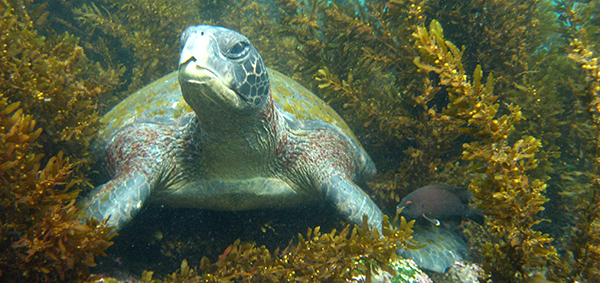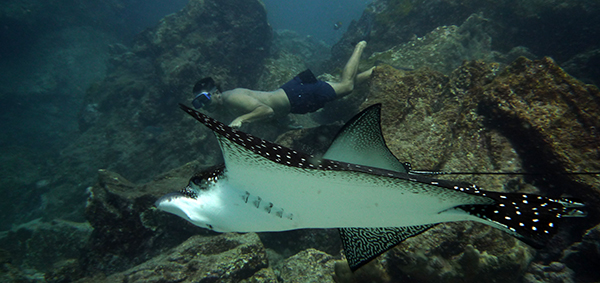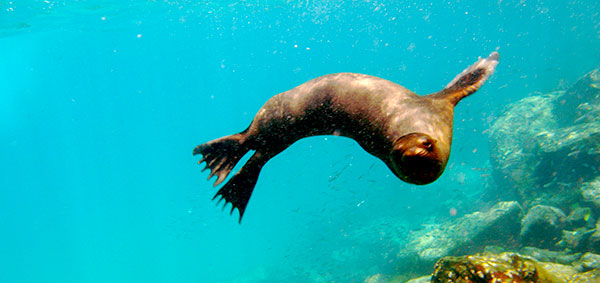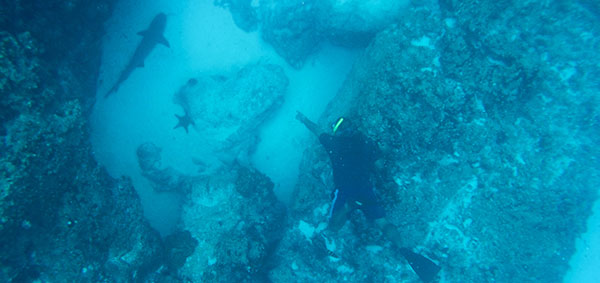Diving in the Galapagos is unique to the islands because they are located in the confluence of seven different oceanic currents. Galapagos is a superb place for diving and is considered one of the seven top spots in the world for this activity.

Additionally, the Galapagos Islands have a high-level of ecosystem protection, so the variety and abundance of Galapagos fish and marine mammal species is astounding.
It is easy to see a diverse number of marine animals and corral underwater. It is best to visit the islands from February to March because this is the beginning of the diving season and it is will not be as busy as the following months.
There are two seasons in the Galapagos Islands and the water temperature at the sea surface ranges between 22oC to 26oC (71.6oF-78.8oF) during the Hot Season that is from December through April. During the Dry Season from May to November the water temperature at sea surface ranges from 18° C to 22° C (64.4oF-71.6oF)
While scuba diving in the Galapagos is considered one of the best places for diving in the world, it is not an ideal place to learn to scuba dive because of the islands’ strong currents, low visibility and cold water.
However, there are still training courses available throughout the islands. A good location to get scuba certification is at Academy Bay, which is the harbor of Santa Cruz Island, the tourist and cultural hub of the islands.
Most dive centers use the same general framework for day dive trips. Generally, day scuba diving packages include two submerges at one dive site as well as full equipment which includes; 6mm wet suit, mask and snorkel, hood, gloves, boots, fins, weight belt, regulator and BCD(buoyancy compensator device).
The most common sites for diving from Puerto Ayora are Gordon Rocks, Cousin’s Rock, North Seymour, Daphne Minor, and Academy Bay among others.
Northern Islands
It takes 12 hours to get to Wolf Island from Santa Cruz Island. Along with king angelfish, there are many different types of reef fish. Depths range from 40 feet to 75 feet below the surface here.
The best place to encounter hammerheads is in the diving area called the Landslide. It is easy to find hawkfish, sea turtles and guineafowl puffer fish here. There are many white-tip reef sharks in the caverns around the island.
Darwin Island is located two hours north of Wolf Island. The island is known for the Arch, which has become a historical monument of the Galapagos, and the diving at the island is north of this site.
The ledges here dip from 50 feet to 70 feet below the surface. It is possible to see moray eels, barber fish, creole fish, bigeye trevally, and triggerfish here.
Wolf Island and Darwin Island are the best places to see the giant whale shark, which appears between April and November. However, it isn’t a guarantee to see this giant animal in these waters.

Central Islands
Gordon Rock is located off of the eastern coast of Santa Cruz. It is known for its occasional strong currents, but also known for its hammerhead sharks that swim 100 feet below the surface, king angelfish that travel in groups of 20, eagle rays swimming parallel to each other, and pelican barracuda.
Isabela Island, one of the largest islands in the Galapagos, has manta rays and sea lions that swim near the shore. The manta rays are hard to get close to but sea lions tend to be quite playful here. There also is yellowfin tuna that lurk in the waters of Isabela.
North Seymour Island is near Santa Cruz Island and is one of the most photogenic sites in the islands. Striated ledges dip from 15 feet down to 80 feet below the surface, and the island is known for the razor surgeonfish that swim in abundance here.
Here, it is possible to see the shy white-tip reef shark, which stays hidden in holes and under ledges. There are also black-striped salema, seahorses, frogfish, and different types of hawkfish.
The island of Santiago is known for its night dives. You can go 50 feet below the surface to see an abundance of small octopuses, and sometimes are able to see batfish at the bottom of the ocean floor.
Santiago is also a great place to spend a few hours hiking. During the day, it is easy to see seal lions playing underwater.
Galapagos underwater world
The Galapagos Islands are world renowned as a SCUBA diving destination: people come from all over to see the turtles, whale sharks, hammerheads, colorful fish and other underwater marvels.

Taking a land tour to see the islands themselves is a bonus that most divers enjoy as well. There has been a lot happening in the islands lately, however, that prospective visitors may need to know.
First the bad news: the combination dive/land tours are a thing of the past. As recently as last year, you could book a live-aboard boat tour that included several dives as well as visits to some of the more popular solid-ground visitor sites.
The well-equipped boats had quality SCUBA gear, as well as trained divemasters for the sea and naturalist guides for the land tours. There were a handful of boats that offered these tours and they were very popular among divers who also wanted to see the giant tortoises, Darwin finches or other spectacular island wildlife.
Unfortunately, in response to the complaints of islanders that about the lack of sustainable local tourism, the Galapagos park service has decided that combination tours are no longer allowed. It’s complicated, but the argument goes like this: by removing the combination boat tour, those interested in diving AND land tours will have to spend more time in the towns of Puerto Ayora or Puerto Baquerizo Moreno.
The locals benefit when tourists stay in town and spend money on hotels, restaurants, tours, etc. For example: a diver books a five-day dive trip but wants some land time, so rather than book another five-day boat tour he stays in town, takes a couple of day trips to other islands and then returns home. Several options for hotel based tours are available at https://www.galapagosislands.com/tours/hotel-based/.
The new plan should work out smashingly for the islanders. Unfortunately, what is best for the islanders is not always best for the tourists, who suddenly have fewer options and now must spend more time and money in the islands if they wish to dive as well as see the islands. Sadly, this is not the first time that the park service has put the interests of tourists last.
But that’s the bad news. The good news is that there has never been a better time to dive in the Galapagos! The dive boats and land-based dive shops are staffed by professionals, feature sound rental equipment and offer reasonable rates. There are many dive shops to choose from, as well as some live-aboard trips for the more serious diver. Introduction dives, Photography courses, certification courses…they’re all available.

Consistently named one of the top sites in the world by diving magazines and web sites, there are numerous outstanding spots to explore. If you head to the far-flung islands of Darwin and Wolf you may see whale sharks and hammerheads, and at any site you’re guaranteed to see dazzling reef fish, eels, rays, sharks, sea turtles and more. Don’t let a little bit of island politics get in the way of a visit to the stunning Galapagos underwater world! For more details on some Live Aboard options, please take a look at https://www.galapagosislands.com/cruises/diving.
“Don’t let a little bit of island politics get in the way of a visit to the stunning Galapagos underwater world ! Check out our Live Aboard options for more details.”



